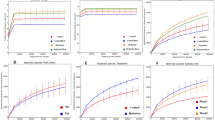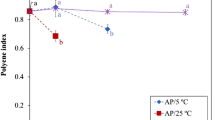Abstract
A NUMBER of investigations has been made to determine the alterations in the microflora of fish caused by irradiation, and in some cases, the subsequent growth patterns of the survivors during refrigerated storage1–4. These investigations have indicated that radiation drastically reduces the Gram-negative micro-organisms normally associated with fish or with fish spoilage and leaves larger numbers of the more radioresistant Gram-positive bacteria and fungi. The nature of the microbial spectrum surviving irradiation depended on the dosage and the initial level of contamination. Subsequent growth of the radiation survivors was then found to be a function of the storage temperature. One variable which has been relatively neglected is the effect of packaging and the accessibility of air on the growth patterns of irradiated seafoods, although certain investigations have indicated that this could be important for ground beef5 and for poultry packed and canned under nitrogen6. In order to evaluate the relationships between radiation, refrigerated storage, and the presence of air, haddock fillets were packaged in cans without hermetic sealing but covered with aluminium foil to allow free exchange of air (FP), sealed with a limited air headspace (LP), or vacuum packed (VP). The samples were then exposed to 150 krads and stored at 3° C for 3 weeks. For taxonomic identification of the various organisms the determinative scheme of Shewan7 was used for the Gram-negative organisms. Gram-positive organisms were determined by standard morphological and biochemical criteria. Three per cent hydrogen peroxide was used for detection of catalase, and for cytochromes the benzidine test was used8. The results indicated that, in addition to a shift in the major microflora caused by radiation, the microbial spectrum is further altered by the presence or absence of air during refrigerated storage.
This is a preview of subscription content, access via your institution
Access options
Subscribe to this journal
Receive 51 print issues and online access
$199.00 per year
only $3.90 per issue
Buy this article
- Purchase on Springer Link
- Instant access to full article PDF
Prices may be subject to local taxes which are calculated during checkout
Similar content being viewed by others
References
MacLean, D. P., and Welander, C., Food Technol., 14, 251 (1959).
Masurovsky, E. B., Voss, J., and Goldblith, S. A., App. Microbiol., 11, 229 (1963).
Corlett, D. A., Lee, J. S., and Sinnhuber, R. O., App. Microbiol., 13, 818 (1965).
Abrahamsson, K., DeSilva, N. N., and Molin, N., Canad. J. Microbiol., 11, 523 (1965).
Jay, M., Kittaka, R. S., and Ordal, Z. J., Food Tech., 16, 95 (1962).
Thornley, M. J., App. Bact., 20, 286 (1957).
Shewan, J. M., in Symposium on Marine Microbiology, 499 (Charles C. Thomas Co., Springfield, Illinois, 1963).
Deibel, R. H., and Evans, J. B., J. Bact., 79, 356 (1960).
Bonneyee, D., Dollar, A., and Liston, J., Bact. Proc., 10 (1966).
Lerke, P., Adams, R., and Farber, L., App. Microbiol., 13, 625 (1965).
Ingram, M., App. Bact., 25, 259 (1962).
Author information
Authors and Affiliations
Rights and permissions
About this article
Cite this article
SINSKEY, T., PABLO, I., SILVERMAN, G. et al. Effect of Packaging on the Major Microbial Flora of Irradiated Haddock. Nature 213, 425–426 (1967). https://doi.org/10.1038/213425a0
Issue Date:
DOI: https://doi.org/10.1038/213425a0
Comments
By submitting a comment you agree to abide by our Terms and Community Guidelines. If you find something abusive or that does not comply with our terms or guidelines please flag it as inappropriate.



